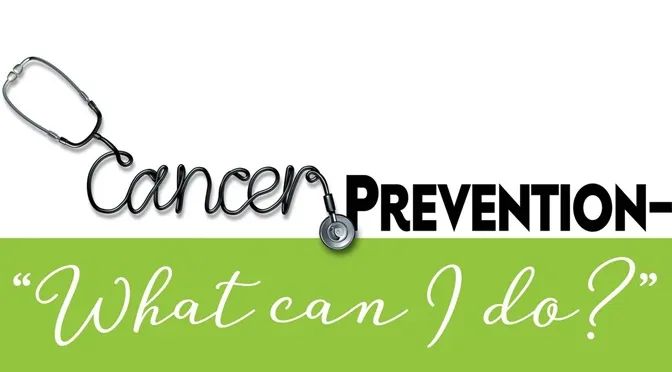
Cancer Prevention: “What can I do?”
Originally printed in the pages of Simply Family Magazine’s February 2017 issue. Never miss an issue, check out SFM's digital editions, here!by David Christianson, M.D., St. Vincent Healthcare Frontier Cancer Center
February is National Cancer Awareness Month, read on as expert physician Dr. David Christianson, of St. Vincent Frontier Cancer Center, shares some practical ways to prevent cancer.
Experts report that 1/3 of all cancer deaths in the United States each year are attributable to lifestyle practices that include: tobacco use, sun exposure, diet, weight, and physical activity.
Tobacco use:
Tobacco use is responsible for approximately 30% of all cancer related deaths in the United States. Tobacco use increases the risk for developing cancer of the mouth, larynx, pharynx, lungs, esophagus, stomach, pancreas, liver, cervix, kidneys, bladder, colon, and is also associated with an increased risk of leukemia.
Sun Exposure:
Sun exposure is a risk factor for skin cancer. Increased risk for both melanomatous and non-melanomatous skin cancer is reported. Experts recommend limiting sun exposure, especially between the hours of 10 a.m. and 2 p.m., and advise using sun protection. This includes wearing hats and other protective clothing, using sunscreen, and wearing sunglasses. Limiting sun exposure should start in childhood and, consistent with the World Health Organization guidelines, anyone under 18 should not use a tanning bed.
Diet:
Vegetable and fruit consumption is associated with lower cancer risk. Diets rich in vegetables and fruits are also associated with lower risk of weight gain and obesity. Studies also suggest a modest association of red meat and processed meat consumption with increased cancer risk. Whole grain foods may reduce risk of cancer involving the gastrointestinal tract. For these reasons the American Cancer Society recommends a diet that includes at least 2.5 cups of vegetables and fruits each day, limits red meats and processed meats, and includes whole grains in preference to refined grain products.
Weight:
14%-20% of cancer-related mortality in the United States is attributed to being overweight and obesity. Increased risk for developing breast, colorectal, endometrial, adenocarcinoma of the esophagus and pancreas is reported. There are also reports of increased risk for developing cancer of the liver, gallbladder, cervix, ovary, prostate and possible increased risk for non-Hodgkin lymphoma and multiple myeloma.
Physical Activity:
Physical activity appears to be associated with cancer risk. Lower levels of physical activity are associated with higher cancer risk. The explanation for this association may primarily be physical activity contributes to maintenance of a healthy body weight. Additionally, physical activity may also be beneficial through helping to regulate sex hormones, insulin, and prostaglandins, and may promote positive effects on the immune system. A lifestyle that is physically active is also associated with a lower risk of heart disease and diabetes.
American Cancer Society Guidelines on Nutrition and Physical Activity for Cancer Prevention:
In an effort to help the general public and medical professionals develop strategies to reduce cancer risk, the American Cancer Society has published guidelines for diet, weight control, and physical activity. A lifestyle that follows The American Cancer Society Guidelines on Nutrition and Physical Activity for Cancer Prevention is associated with lower mortality from cancer and cardiovascular disease. The American Cancer Society Guidelines on Nutrition and Physical Activity for Cancer Prevention are consistent with those established by the American Heart Association and American Diabetic Association.
Here are some practical recommendations from the American Cancer Society for individuals as well as communities to lower the risk of cancer.
American Cancer Society recommendations for individuals-
Achieve and maintain a healthy weight throughout life.
- Be as lean as possible throughout life without being underweight. Experts consider a healthy BMI to be within the range of 18.5 to 25.0 kg/m2. A BMI between 25.0 and 29.9 kg/m2 is considered overweight, and a BMI of 30.0 kg/m2 and over to be obese.
- Avoid excess weight gain at all ages. For those who are currently overweight or obese, losing even a small amount of weight has health benefits and is a good place to start.
- Engage in regular physical activity and limit consumption of high-calorie foods and beverages as key strategies for maintaining a healthy weight.
Adopt a physically active lifestyle.
- Adults should engage in at least 150 minutes of moderate intensity or 75 minutes of vigorous intensity activity each week, or an equivalent combination, preferably spread throughout the week.
- Children and adolescents should engage in at least 1 hour of moderate or vigorous intensity activity each day, with vigorous intensity activity occurring at least 3 days each week.
- Limit sedentary behavior such as sitting, lying down, watching television, or other forms of screen-based entertainment.
- Doing some physical activity above usual activities, no matter what one's level of activity, can have many health benefits.
Consume a healthy diet, with an emphasis on plant foods.
- Choose foods and beverages in amounts that help achieve and maintain a healthy weight.
- Limit consumption of processed meat and red meat.
- Eat at least 2.5 cups of vegetables and fruits each day.
- Choose whole grains instead of refined grain products.
If you drink alcoholic beverages, limit consumption.
- Consume no more than 1 drink per day for women or 2 per day for men.
American Cancer Society Recommendations for community action-
Public, private, and community organizations should work collaboratively at national, state, and local levels to implement policy and environmental changes that:
- Increase access to affordable, healthy foods in communities, worksites, and schools, and decrease access to and marketing of foods and beverages of low nutritional value, particularly to youth.
- Provide safe, enjoyable, and accessible environments for physical activity in schools and worksites, and for transportation and recreation in communities.
 About the author...David Christianson M.D. received his undergraduate training at North Dakota State University, Bartlesville Wesleyan College, and the University of Oklahoma.
About the author...David Christianson M.D. received his undergraduate training at North Dakota State University, Bartlesville Wesleyan College, and the University of Oklahoma.
He then received his medical degree from the University of Oklahoma. Dr. Christianson completed his internal medicine residency at the University of Oklahoma and his medical oncology fellowship at the University of Missouri.
Growing up in North Dakota and Montana he always wanted to return to this area. In 2004 he and his family moved to Billings where he joined the physicians and staff at St Vincent Healthcare.
